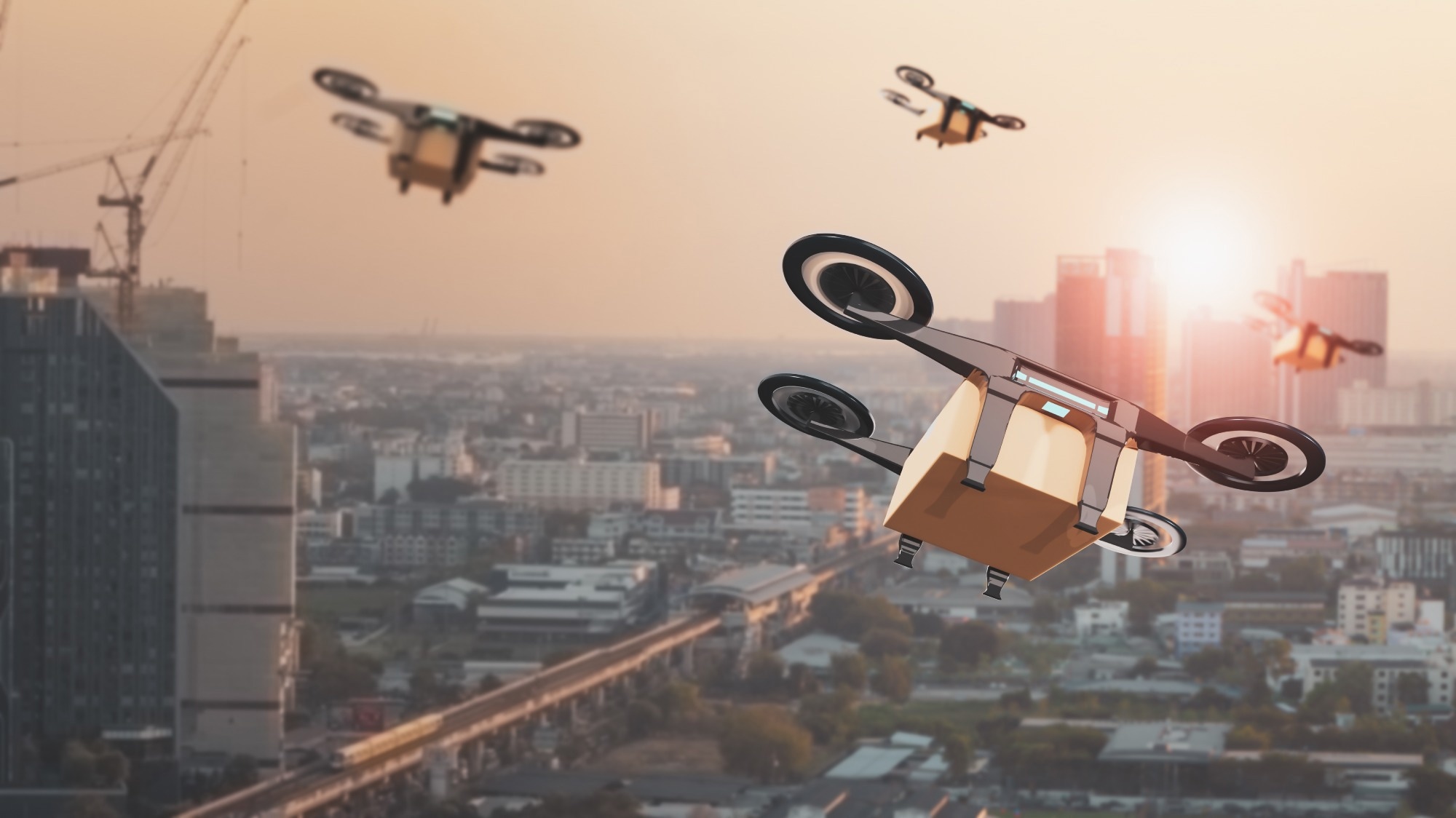In a paper published in the journal Drones, researchers explored the Internet of Drones (IoD) as a decentralized network that enhanced drone applications like package delivery, traffic surveillance, and rescue operations by highlighting the advantages of IoD-integrated unmanned aerial vehicles (UAVs), such as high mobility and improved connectivity.
 Study: Blockchain and Drones: A Decentralized Revolution. Image Credit: ART STOCK CREATIVE/Shutterstock
Study: Blockchain and Drones: A Decentralized Revolution. Image Credit: ART STOCK CREATIVE/Shutterstock
The study also examined how blockchain technology boosted IoD by offering superior security and decentralized features for smart applications. Integrating IoD and blockchain presented challenges and open issues despite the promising benefits. The researchers provided a comprehensive survey of IoD and blockchain technologies, analyzed their synergy, and discussed future directions and challenges in deploying decentralized IoD solutions.
Evolving IoD Connectivity
Past work on UAVs has evolved from individual drone operations to the interconnected IoD ecosystem, enabling coordinated missions across various applications such as agriculture, package delivery, and surveillance. As part of the Internet of Things (IoT), the IoD leverages interconnected devices and sensors for enhanced flexibility, mobility, and autonomy but also inherits IoT's security vulnerabilities. Blockchain technology addresses these issues by providing secure, transparent, decentralized data sharing, improving authentication, privacy, and integrity.
How Does the IoD Work?
The IoD facilitates the coordination and interconnection of drones through a three-layer network: air traffic control, cellular, and the Internet. It ensures efficient UAV operations with protocols like micro air vehicle link (MAVLink) and robot operating system Link (ROSLink), supporting scalability and data fusion. The architecture relies on 5G networks for seamless coverage, high-definition transmission, and real-time control. Security is paramount, addressing risks like device mimicry, data tampering, and malware, necessitating robust encryption, authentication, and regular updates to protect against unauthorized access and ensure reliable drone operations.
Blockchain Integration in IoD
Blockchain technology is characterized by its interconnected data blocks secured through cryptographic hashing, revolutionizing various industries with its decentralized and transparent nature. The blockchain architecture comprises five layers, starting with the foundational hardware layer, followed by the data layer responsible for storage and validation. The network layer facilitates secure communication among nodes, while the consensus layer ensures agreement on transaction validity.
At the application layer, users interact with the blockchain through wallets, decentralized applications (dApps), and user interfaces, enabling various functionalities such as asset tokenization and decentralized finance. Blockchain's core principles of distribution, immutability, and decentralization enhance fault tolerance and security, making it a promising technology for diverse applications.
Integrating blockchain with the IoD holds immense potential in transforming operational paradigms within the drone ecosystem. The IoD can enhance data integrity, accountability, and privacy in drone communications and operations by leveraging blockchain's features, including distributed ledgers and cryptographic security. Blockchain enables automated privacy preservation and secure sharing of drone data, addressing challenges such as authentication, data protection, and collision prevention.
Additionally, blockchain's consensus mechanisms ensure reliable interconnection among drones, although challenges remain in maintaining reliability amidst dynamic topologies and wireless communications. Overall, blockchain's contribution to IoD systems offers a robust framework for optimizing drone operations and fostering innovation in unmanned aerial technologies.
Technological Synergy Unleashed
Integrating blockchain and the IoD relies on a symbiosis of technologies to unlock their full potential. Artificial intelligence (AI) drives IoD systems with machine learning (ML) for autonomous decision-making, while blockchain ensures secure data storage and sharing. Local AI training enables drones to operate autonomously, enhancing transaction security and automation. Cloud computing supports vast data requirements, while edge computing reduces latency and improves security. Additionally, IoT facilitates real-time data acquisition. Communication technologies like 5G and anticipated 6G networks enable seamless connectivity and high-speed data transmission, forming a robust ecosystem for blockchain-IoD integration, revolutionizing drone operations, and fostering innovation.
IoD Blockchain Synergies
Integrating blockchain with the IoD presents many transformative use cases across industries. These include bolstered supply chain transparency and traceability, streamlined healthcare delivery through remote consultations and secure patient data management, efficient disaster response, and recovery aided by real-time drone monitoring, sustainable agriculture practices with precise crop management, enhanced transportation logistics with maintenance record-keeping and automated insurance claims, and innovative media content creation and distribution ensuring copyright protection and fair compensation for creators.
Together, these applications leverage the synergies of IoD and blockchain technologies to revolutionize operations, enhance security, and foster trust and accountability across diverse sectors.
Summary
In conclusion, this paper delved into the convergence of IoD and blockchain technologies, uncovering their potential synergy and impact. Blockchain's integration with IoD systems transcends traditional security roles, offering avenues for enhanced automation and efficiency.
The analysts found common features when examining use cases: drones' data collection capabilities and blockchain's immutable storage enable secure real-time data sharing. Future research should optimize resource allocation, ensure seamless integration between IoD and blockchain, and leverage blockchain data for efficient drone task coordination.
Journal reference:
Tychola, K. A., Voulgaridis, K., & Lagkas, T. (2024). Beyond Flight: Enhancing the Internet of Drones with Blockchain Technologies. Drones, 8:6, 219. https://doi.org/10.3390/drones8060219, https://www.mdpi.com/2504-446X/8/6/219.